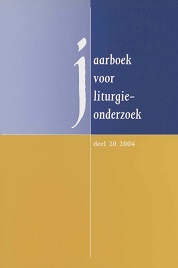De ruimtelijke dispositie van de gemeenschapsliturgie
Abstract
The prevalent liturgical disposition of Roman-Cathohc churches goes back to initiatives and experiments of the Liturgical Movement. Since Vatican II this has become accepted worldwide. Characteristic for this disposition is the extension of the chancel into the nave and the location of a freestanding altar suitable for the celebratio versus populum. The liturgical rituals were performed in this renewed sanctuary, soon denoted as ‘liturgical centre’. Increasingly, persons, actions and objects were situated here. The priest, lector, cantor, acolytes, musicians and the choir are positioned in the liturgical centre, as are the bride and groom at the wedding ceremony or the children at a family service. The altar and ambo are positioned here, as are the cross, the Easter candle, the Advent wreath, piano and organ and images which visualize the theme of the celebration. The liturgical center is a stage, a Bühne where the ritual is performed. The community takes part from a distance as an onlooker and listener. The most important change of this new arrangement or re-ordering is the creation of a different kind of interaction. The traditional dichotomy of the space has remained, but has acquired a polemic character, because the liturgical center and the nave are now emphatically in opposition. Functionaries (priest, lector, choir) and community are situated face to face, opposite of each other. As a consequence the most important form of communication is set between the two poles: the liturgical center (the leaders) and the nave (the community). The rediscovery and revaluation of the community aspect of the liturgy and the meaning of the community as the subject of liturgy do not match with this dichotomy. The basic dynamics of the liturgy exist of a double movement: the interaction between God and man. God speaks to mankind and man turns to God in praising, thanking and begging. This double movement is ritually expressed through both listening to the Bible and praying, and is materialized through both ambo and altar. The communio model with its elliptic disposition can support and strengthen this interaction threedimensionaUy. This is shown in the new disposition of St. Joseph church (Nijmegen), that has applied this model as a true reflection of the basic structure of the liturgy.


